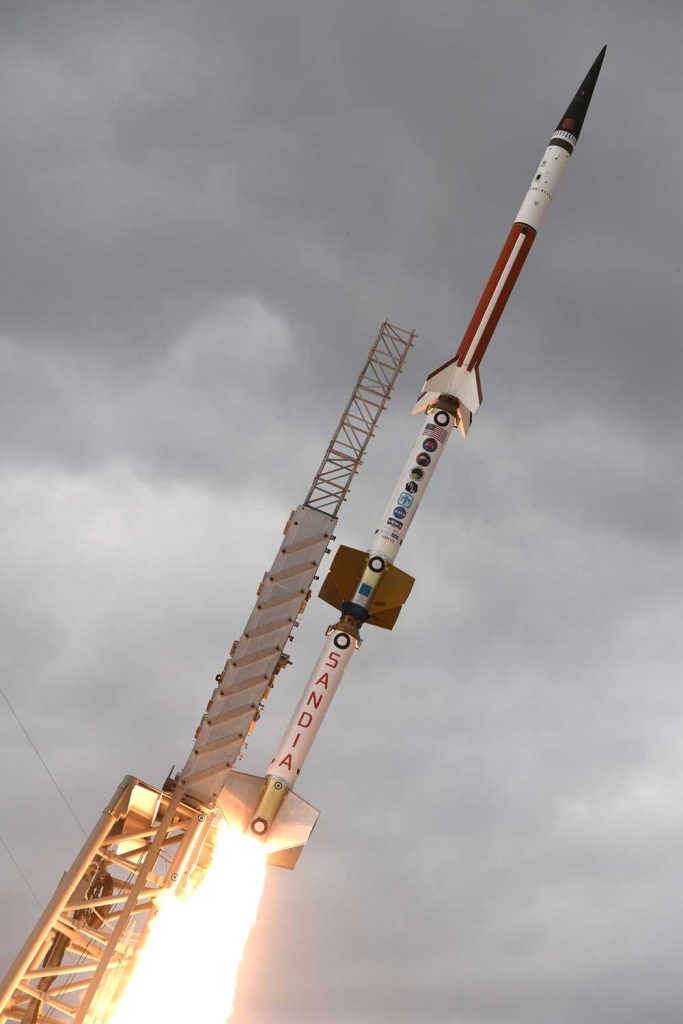New vehicle imitates boost-glide trajectory for over a minute

Sandia’s High Operational Tempo for Hypersonics team successfully executed another flight test campaign to inform hypersonic weapon design for the U.S. Navy and Army. The team flew two precision sounding rockets carrying a total of 24 experiments Oct. 26-27 from NASA’s Wallops Flight Facility in Virginia.
The flight campaign supported the Navy’s Conventional Prompt Strike and the Army’s Long Range Hypersonic Weapon offensive programs. The Missile Defense Agency also gathered data from the tests to help develop defensive systems against hypersonic weapons.
The pair of launches is the second campaign for the Sandia team, which executed its first campaign in October 2021. Over the yearlong course of the campaign, the team designed and flew an entirely new three-stage sounding rocket, launched in a highly depressed trajectory intended to represent the hypersonic boost-glide flight path of larger, more expensive weapons systems.
“This vehicle was a revolutionary success, spending approximately one minute above Mach 9 in a relevant altitude band, which is an unprecedented accomplishment for a sounding rocket,” said Ben English, who leads the High Operational Tempo for Hypersonics team. The vehicle survived a total of 85 seconds in a relevant flight environment.
The other rocket followed a more traditional, high-arc, lofted trajectory but included numerous advanced flight sequencing events orchestrated to facilitate critical demonstrations for its onboard payloads.
“Our team did a fantastic job raising an already high bar set from last year’s campaign,” Ben said. “Sandia has a long history supporting complex flight tests, including extensive contributions to hypersonics development, and the incredible efforts of this team throughout this campaign have brought another highly effective tool into our nation’s testing and development arsenal. What that means for the Labs is that I can talk to potential sponsors or partners who are getting more interested in these kinds of high-intensity flights and say without hesitation, ‘Yeah, we can do that.’”
Sounding rocket programs at Sandia date back to atmospheric nuclear weapons tests in the 1950s. During those experiments, several rockets carrying scientific instruments would record data about atomic blasts. The current rockets, on the other hand, help to rapidly mature hypersonic systems technologies, such as a nose tip provided by Oak Ridge National Laboratory incorporating advanced materials.
The frequency and affordability of the sounding rocket launches helps these technologies grow more mature before the Navy and Army programs field a final weapon system design, according to a Navy news release.
“Several of the payloads flown on these tests will transition directly to tactical weapon systems upgrades based on the pedigree and demonstrated performance observed on these flights,” Ben said.
Other payloads, including navigation and communications equipment, were provided by Conventional Prompt Strike, the Missile Defense Agency, the Army Hypersonic Program Office, the Joint Hypersonic Transition Office, Sandia, the Applied Physics Laboratory at Johns Hopkins University and several defense contractors.
Sandia is the lead research agent for the common hypersonic missile that will be fielded by both the Navy and Army with tailored launchers. The Labs designed the common hypersonic glide body that is attached to a rocket booster and launched into the upper atmosphere before gliding to a target at more than five times the speed of sound.